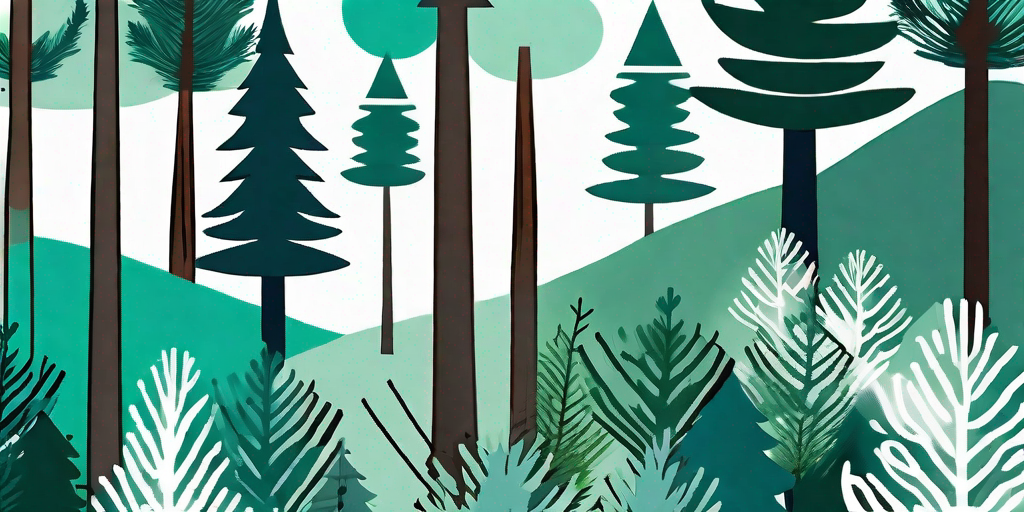
Welcome to the world of coniferous trees, where every day is Christmas, and the air is always fresh. These evergreen wonders are more than just holiday decorations, they're the backbone of many ecosystems and provide numerous benefits to humans and wildlife alike. So, let's dive into the deep end of the pine needle pile and explore the beauty and benefits of coniferous trees.
The Basics of Coniferous Trees
Before we start our journey, let's get our bearings straight. Coniferous trees, also known as conifers, are predominantly evergreen trees that produce cones and have needle-like or scale-like leaves. They're the cool kids of the tree world, always dressed in green and never shedding their leaves, unlike their deciduous counterparts.
Conifers are found all over the world, from the cold regions of the Arctic Circle to the hot deserts of Africa. Some of the most common types of conifers include pines, firs, spruces, and cedars. Each of these has its own unique characteristics and benefits, but they all share the common trait of being incredibly resilient and adaptable.
Understanding Coniferous Tree Anatomy
Coniferous trees are like the superheroes of the plant world, equipped with special features that help them survive in a variety of conditions. Their needle-like leaves are covered in a waxy coating that prevents water loss, making them perfect for dry climates. The shape of the needles also allows snow to easily slide off, preventing damage in winter conditions.
The cones of coniferous trees are also quite fascinating. They're not just there for decoration, they play a crucial role in reproduction. The cones contain the seeds of the tree, which are spread by the wind or by wildlife. Some cones even require fire to open and release their seeds, a testament to the resilience of these trees.
The Benefits of Coniferous Trees
Now that we've covered the basics, let's delve into the many benefits of coniferous trees. These trees are not just pretty to look at, they're also incredibly beneficial to the environment and to humans.
Coniferous trees play a crucial role in carbon sequestration, helping to mitigate the effects of climate change. They also provide habitat and food for a variety of wildlife, from birds to mammals. In addition, they help prevent soil erosion and contribute to water purification.
Coniferous Trees and Climate Change
Coniferous trees are like nature's vacuum cleaners, sucking up carbon dioxide from the atmosphere and storing it in their trunks, branches, and roots. This process, known as carbon sequestration, is a key part of the global carbon cycle and helps to mitigate the effects of climate change.
Furthermore, coniferous forests have a cooling effect on the environment. They reflect sunlight back into space and release moisture into the atmosphere, helping to regulate the Earth's temperature. So, by planting more coniferous trees, we can help combat global warming.
Coniferous Trees and Wildlife
Coniferous forests are bustling with life. They provide habitat for a variety of wildlife, from birds that nest in their branches to mammals that feed on their cones. Some species, like the red squirrel and the crossbill, are specially adapted to live in coniferous forests and rely on these trees for their survival.
But it's not just wildlife that benefits from coniferous trees. These trees also provide humans with numerous resources, including timber, resin, and edible seeds. They're also a source of inspiration for artists and a place of peace and tranquility for nature lovers.
FAQs about Coniferous Trees
- Are all coniferous trees evergreen?
- While most coniferous trees are evergreen, not all of them are. Some, like the Larch and the Bald Cypress, are deciduous and shed their needles in the fall.
- What's the tallest coniferous tree?
- The tallest coniferous tree is the Coast Redwood, which can grow up to 379 feet tall. That's taller than the Statue of Liberty!
- Can I plant a coniferous tree in my backyard?
- Absolutely! Just make sure to choose a species that's suitable for your climate and soil conditions. Also, remember that some conifers can grow quite large, so make sure you have enough space.
Conclusion
Coniferous trees are truly remarkable. They're not just beautiful to look at, they also provide numerous benefits to the environment and to humans. Whether it's their role in mitigating climate change, their importance for wildlife, or their use as a resource, these trees are a crucial part of our world.
So, the next time you see a coniferous tree, take a moment to appreciate its beauty and its contributions. And who knows, you might just be inspired to plant one in your own backyard!















